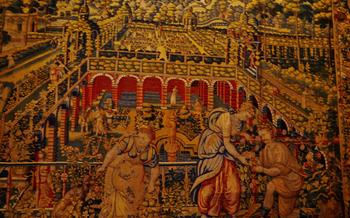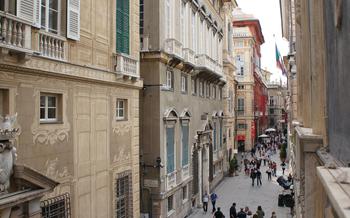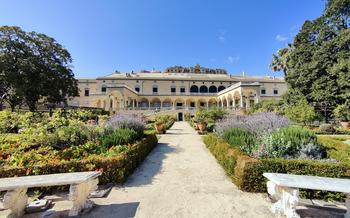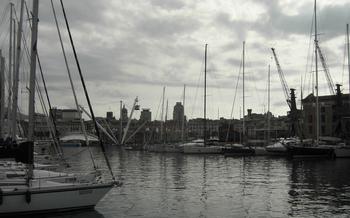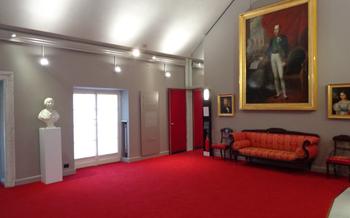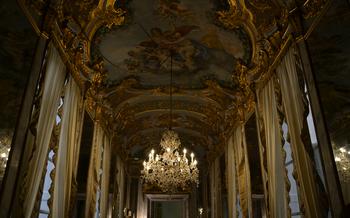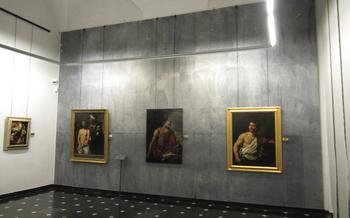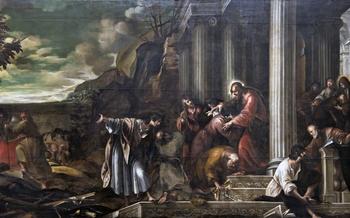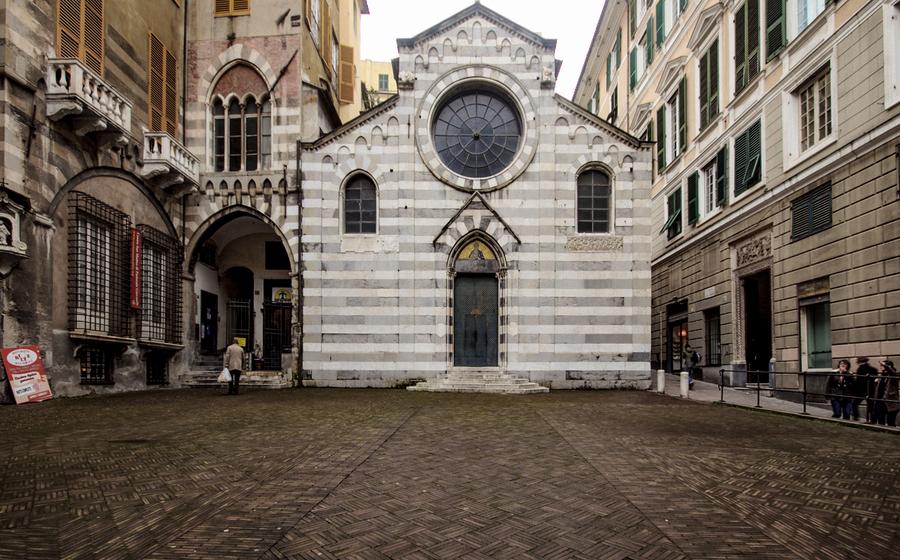
Piazza San Matteo
- Introduction: A Journey into the Heart of Genoa's Maritime Glory
- The Piazza's Layout
- The San Matteo Church
- The Palazzo San Giorgio
- The Loggia della Mercanzia
- The Torre Grimaldina
- The Palazzo Bianco
- The Palazzo Rosso
- A Walk Through History
- Enjoy the Views
- Shopping
- Festivals and Events
- Practical Tips
- Insider Tip: The Secret Rooftop Terrace
Introduction: A Journey into the Heart of Genoa's Maritime Glory
Genoa, the vibrant capital of Liguria, is a city steeped in history, culture, and maritime traditions. Its iconic Piazza San Matteo, nestled in the heart of the Old Town, stands as a testament to the city's glorious past as a powerful maritime republic.
The Piazza San Matteo has witnessed centuries of transformation, serving as a bustling center of commerce, politics, and religion. Today, it remains a vibrant hub of activity, surrounded by architectural marvels that tell the story of Genoa's rise to prominence as a maritime superpower.
Situated just a short walk from the waterfront, the Piazza San Matteo is easily accessible by foot or public transportation. Its central location makes it an ideal starting point for exploring Genoa's historic center, a UNESCO World Heritage Site.
As you step into the Piazza San Matteo, prepare to be captivated by its harmonious blend of architectural styles, from the Romanesque simplicity of the San Matteo Church to the opulent Renaissance elegance of the Palazzo San Giorgio and the Palazzo Bianco. The square's vibrant atmosphere, with locals and tourists alike, adds to its charm, creating a vibrant tapestry of colors, sounds, and stories.
The Piazza's Layout
The Piazza San Matteo is a visually striking and architecturally diverse square. The central focus is the San Matteo Church, with its Gothic facade and ornate interior. To the left of the church stands the Palazzo San Giorgio, a 13th-century palace with a striking black-and-white striped exterior. On the opposite side of the square is the Loggia della Mercanzia, a 16th-century building that once housed the city's merchants. The Palazzo Bianco and the Palazzo Rosso, two adjacent palaces that are now art museums, are located at the far end of the square.
The buildings surrounding the Piazza San Matteo are adorned with intricate details, sculptures, and frescoes. Each building has its own unique architectural style, reflecting the different periods in Genoa's history. The overall effect is one of harmony and grandeur, creating a visually stunning space that captures the essence of Genoa's rich heritage.
One of the most notable features of the square is the Torre Grimaldina, a 14th-century tower that stands at the corner of the Palazzo San Giorgio. The tower, which was once used as a prison, offers panoramic views of the city and the surrounding countryside.
The San Matteo Church
The San Matteo Church is a splendid example of Genoese Gothic architecture, showcasing a striking facade adorned with intricate carvings and sculptures. Its construction, initiated in the 12th century, spanned several centuries, with various modifications and additions made over time. The church's exterior boasts a captivating blend of Romanesque and Gothic elements, including a series of elegant arches and a stunning rose window that casts a warm, diffused light into the interior.
Step inside the San Matteo Church, and you will be greeted by a breathtaking spectacle of art and architecture. The church's interior is a testament to the devotion and artistry of its creators. The layout features a central nave flanked by two aisles, supported by graceful columns and topped by a series of pointed arches. The walls and ceiling are adorned with intricate frescoes depicting religious scenes and biblical narratives, creating a sense of awe and wonder.
Among the highlights of the San Matteo Church is the Cappella di San Giovanni Battista, a small chapel to the right of the main altar. This chapel is adorned with opulent decorations and houses an exquisite marble statue of John the Baptist, a masterpiece attributed to the renowned sculptor Filippo Parodi. The church also features several other notable works of art, including paintings by Bernardo Strozzi and Luca Cambiaso, adding to its rich artistic heritage.
The San Matteo Church stands as a testament to the enduring legacy of Genoa's past and continues to serve as a place of worship while also welcoming visitors from around the world. Its blend of architectural styles, stunning interior, and historical significance make it a must-visit destination for anyone exploring the wonders of Piazza San Matteo.
The Palazzo San Giorgio
The Palazzo San Giorgio is a historic building situated in Piazza San Matteo, Genoa, Italy. It was built in the 13th century and has served various purposes throughout its existence. Originally constructed as a residence, it later became the seat of the Bank of Saint George, a powerful financial institution that played a significant role in Genoa's maritime trade and expansion.
The Palazzo San Giorgio exhibits a Gothic architectural style with a simple yet elegant facade. Its exterior is characterized by a series of pointed arches, decorative windows, and a crenellated parapet. The building's interior features a large courtyard surrounded by arcades and staircases, showcasing its historical significance and grandeur.
Over the centuries, the Palazzo San Giorgio has undergone several renovations and modifications. In the 16th century, it was expanded to accommodate the growing needs of the bank and adorned with Renaissance-style elements. During the 19th century, the building was restored and converted into a museum, showcasing artifacts and documents related to Genoa's maritime history and the Bank of Saint George.
Today, the Palazzo San Giorgio houses the Museo del Banco di San Giorgio, which offers visitors a glimpse into the fascinating world of this ancient financial institution. The museum exhibits a collection of precious artifacts, including ledgers, coins, and maritime charts, providing insights into the economic and commercial activities of Genoa during the Middle Ages and the Renaissance.
The Loggia della Mercanzia
The Loggia della Mercanzia, an architectural masterpiece situated in the Piazza San Matteo, stands as a testament to Genoa's rich history and mercantile prowess. Constructed in the mid-16th century, this elegant building epitomizes the architectural style prevalent during the Renaissance period. Its graceful arcades, supported by slender columns and adorned with intricate carvings, create a harmonious interplay of light and shadow.
Originally conceived as the seat of Genoa's powerful merchant guild, the Loggia della Mercanzia served as a vibrant hub for trade and commerce. Merchants from across the globe congregated here to conduct business, negotiate deals, and exchange goods. The loggia's strategic location, at the heart of Genoa's commercial district, facilitated the flourishing of trade and contributed to the city's economic prosperity.
Today, the Loggia della Mercanzia has undergone a transformation and now serves as an exhibition space, hosting a variety of art exhibitions and cultural events throughout the year. These exhibitions showcase the works of both established and emerging artists, providing visitors with an opportunity to engage with contemporary art and appreciate the diverse talents of the region.
The Torre Grimaldina
The Torre Grimaldina, also known as the Torre del Porto, stands as a testament to Genoa's rich maritime history. Built in the 13th century as a watchtower, this imposing structure served as a vital defense mechanism for the city. Its strategic location at the entrance of the old port allowed guards to monitor incoming and outgoing vessels, ensuring the safety and security of Genoa's maritime trade.
The tower's architectural style reflects the influence of the Ligurian Gothic period, characterized by its austere lines and simple yet elegant design. Constructed using local limestone, the Torre Grimaldina boasts a cylindrical shape with a slightly tapered profile. Its sturdy walls, punctuated by narrow windows, exude an aura of strength and resilience.
Over the centuries, the Torre Grimaldina has undergone several modifications and renovations. In the 16th century, it was reinforced and equipped with artillery to enhance its defensive capabilities. During the 19th century, the tower was converted into a lighthouse, guiding ships safely into the port of Genoa.
Today, the Torre Grimaldina stands as a museum, inviting visitors to explore its fascinating history and admire the panoramic views from its rooftop terrace. Within the tower's walls, exhibits showcase the rich maritime heritage of Genoa, including ancient maps, navigational instruments, and artifacts that tell the story of the city's seafaring past.
As you climb the spiral staircase to the top of the tower, you will be rewarded with breathtaking views of the Piazza San Matteo, the old port, and the sparkling Mediterranean Sea. The city's iconic landmarks, including the Lanterna lighthouse and the historic center, can be seen from this vantage point, offering a unique perspective on Genoa's vibrant cityscape. So, be sure to add a visit to the Torre Grimaldina to your itinerary for an immersive experience that combines history, culture, and breathtaking panoramas.
The Palazzo Bianco
The Palazzo Bianco, located in the heart of the Piazza San Matteo, is a majestic palace that serves as a prominent cultural institution in Genoa. Its history dates back to the 16th century when it was constructed by the wealthy Grimaldi family. Originally known as the Palazzo Doria Tursi, it underwent several transformations before becoming a public museum in the 19th century.
The Palazzo Bianco boasts an impressive collection of artworks spanning various periods and styles. Visitors can admire masterpieces by renowned artists such as Caravaggio, Rubens, and Van Dyck, as well as significant works by local Ligurian painters. Among the highlights are "Ecce Homo" by Antonello da Messina, "The Martyrdom of Saint George" by Rubens, and "The Rest on the Flight into Egypt" by Caravaggio.
The museum also houses a notable collection of decorative arts, including ceramics, furniture, and tapestries, providing a glimpse into the opulent lifestyle of the Genoese aristocracy. Temporary exhibitions and cultural events are frequently organized, adding to the dynamic atmosphere of the Palazzo Bianco.
Exploring the Palazzo Bianco offers a journey through art history, inviting visitors to discover the diverse artistic expressions that have shaped Genoa's cultural heritage. With its rich collections and captivating exhibitions, the Palazzo Bianco stands as a testament to the city's enduring legacy as a center of artistic excellence.
The Palazzo Rosso
The Palazzo Rosso, located in the heart of the Piazza San Matteo, is a majestic palace that commands attention with its grand facade and rich history. Built in the 17th century by the Brignole Sale family, one of Genoa's most prominent noble families, the palace showcases a harmonious blend of Baroque and Renaissance architectural styles. Its striking red exterior, adorned with intricate carvings and balconies, gives it its distinctive name, Palazzo Rosso, meaning "Red Palace."
Step inside the palace to be greeted by opulent interiors and a remarkable collection of artworks. The walls of the grand halls are adorned with stunning frescoes and paintings by renowned artists, including Tintoretto, Veronese, and Van Dyck. Each room tells a story of the palace's illustrious past, from lavish banquets to political gatherings.
The highlights of the Palazzo Rosso's collection include masterpieces such as "The Conspiracy of Catiline" by Tintoretto, a dramatic depiction of a historical event, and "The Rape of Europa" by Veronese, a vibrant and sensual portrayal of the mythical abduction. The palace also houses a collection of ancient sculptures, tapestries, and furniture, offering a glimpse into the refined lifestyle of the Brignole Sale family.
Today, the Palazzo Rosso is a public museum open to visitors, inviting them to explore its rich history, admire its artistic treasures, and experience the grandeur of Genoese nobility.
A Walk Through History
To fully appreciate the rich tapestry of history that the Piazza San Matteo holds, embark on a leisurely stroll through its cobblestone streets. Begin your journey at the imposing San Matteo Church, where you can admire its grand facade and intricate carvings. From there, proceed to the Palazzo San Giorgio, a former banking institution that now houses the Banca Carige. Marvel at its opulent frescoes and learn about its pivotal role in Genoa's maritime history.
As you continue your walk, take a moment to appreciate the Loggia della Mercanzia, an elegant loggia that once served as a meeting place for merchants. Today, it plays host to various exhibitions and cultural events. Don't forget to glance upwards to admire the Torre Grimaldina, a resilient 13th-century tower that has stood witness to centuries of change.
Next on your itinerary are the Palazzo Bianco and the Palazzo Rosso, two neighboring palaces that now serve as art museums. Explore their impressive collections, which showcase masterpieces by renowned artists such as Caravaggio, Veronese, and Rubens.
As you wander through the piazza, let your imagination transport you back in time. Picture the bustling marketplace that once occupied this space, filled with the sounds of haggling merchants and the aroma of exotic spices. Imagine the grand processions and celebrations that took place here, as the people of Genoa came together to mark important occasions.
Conclude your historical promenade by pausing to admire the panoramic views from the piazza. Gaze out over the rooftops of Genoa, with the majestic Ligurian Alps forming a breathtaking backdrop. Let the beauty of this timeless square wash over you, as you reflect on the countless stories that have unfolded within its walls.
Enjoy the Views
The Piazza San Matteo offers breathtaking panoramic views of Genoa and its surroundings. From the square, visitors can admire the city's historic center, with its narrow streets and colorful buildings, as well as the picturesque harbor with its multitude of boats and ships. On clear days, it is even possible to see the distant Ligurian Alps, providing a stunning backdrop to the cityscape.
One of the best places to enjoy the views is from the top of the Torre Grimaldina. This 14th-century tower offers 360-degree views of the city, allowing visitors to take in the grandeur of Genoa from a unique perspective. Another great spot for panoramic views is the terrace of the Palazzo Bianco, which offers a bird's-eye view of the Piazza San Matteo and the surrounding area.
For those who prefer to stay on ground level, there are several cafes and restaurants in the piazza that offer outdoor seating with lovely views. Visitors can relax with a drink or a meal while they soak in the atmosphere of this historic square and admire the beauty of Genoa.
Shopping
The Piazza San Matteo and the surrounding streets offer a delightful shopping experience, blending traditional Genoese crafts with modern boutiques and luxury brands. Along Via San Lorenzo, visitors can find a treasure trove of antique shops, art galleries, and jewelry stores, while Via Garibaldi, with its elegant palaces, is home to high-end fashion boutiques and flagship stores of renowned brands. For a more authentic shopping experience, head to the Mercato Orientale, a lively market where you can find fresh produce, local delicacies, and handmade souvenirs.
Those seeking unique and locally crafted items should visit the shops in the alleys branching off the Piazza San Matteo. Here, you can find artisans creating custom-made leather goods, intricate glasswork, and delicate filigree jewelry. For a truly special souvenir, don't miss the opportunity to purchase a piece of "ceramica ligure," hand-painted pottery featuring traditional Genoese motifs.
Festivals and Events
The Piazza San Matteo comes alive during the many festivals and events held throughout the year. These events offer a glimpse into the vibrant culture and traditions of Genoa and are a great opportunity to experience the city's unique atmosphere.
One of the most popular events is the Festa di San Matteo, which takes place every September. This festival celebrates the patron saint of Genoa and features religious processions, live music, traditional dancing, and street food stalls.
Another highlight is the Rolli Days, held in May and October. During these days, some of Genoa's most beautiful palaces, usually closed to the public, open their doors for visitors to explore their opulent interiors.
For art enthusiasts, the Genova Art Week in October offers a variety of exhibitions, workshops, and cultural events showcasing local and international artists.
If you're looking for a unique experience, don't miss the Palio Marinaro, a traditional boat race held in May. Teams from different districts of Genoa compete in a thrilling race on the waters of the Old Port, accompanied by music and cheering crowds.
These are just a few of the many festivals and events that take place in the Piazza San Matteo throughout the year. Be sure to check the local calendar to see what's happening during your visit.
Practical Tips
-
Accessibility and facilities: The Piazza San Matteo is generally accessible, with cobblestone streets and ramps for wheelchairs. Public restrooms are available in the Palazzo San Giorgio.
-
Getting around and avoiding crowds: The piazza is a popular tourist spot, so it can get crowded during peak season. To avoid the crowds, visit early in the morning or late in the evening. If you're driving, be aware that parking is limited in the area.
-
Dress code and etiquette: There is no specific dress code for visiting the Piazza San Matteo, but it's recommended to dress respectfully, especially when visiting the churches. Avoid wearing shorts or tank tops when entering religious buildings.
Insider Tip: The Secret Rooftop Terrace
For an unforgettable experience, climb to the rooftop terrace of the Palazzo Bianco. This hidden gem offers breathtaking panoramic views of the Piazza San Matteo and the surrounding cityscape. Soak in the beauty of Genoa's terracotta rooftops, medieval towers, and the glistening Mediterranean Sea in the distance. This exclusive viewpoint is the perfect place to capture stunning photographs and create lasting memories of your visit.
